Introduction
The rough green snake is a member of the Colubridae snake family. They originate in North America and are relatively short – they grow to between two and three feet and are a lovely bright emerald green color with a lighter underbelly.
Their eyes are large and they are very attractive to look at which makes them popular pets. Because they are not hard to look after and are fairly robust, they make good reptile pets for beginners but are also popular with experienced reptile owners.
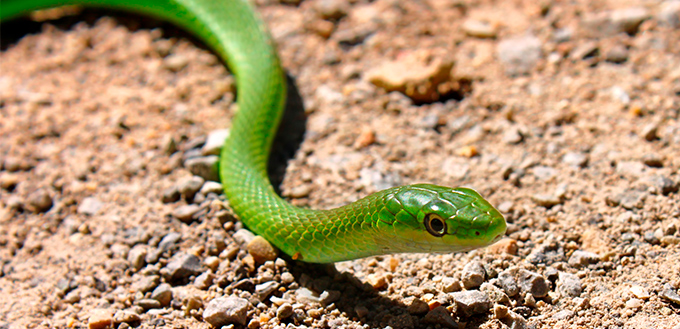
Rough Green Snake Behavior
Your rough green snake will not be poisonous or venomous so they are safe to handle. When they are hunting in the wild, they do not kill their prey before they eat it. They sneak up on it from behind and swallow it whole.
However, this does not mean that you need to worry about getting bitten because they hardly ever bite humans. They are regarded as very gentle snakes and have a docile nature which makes them a popular pet for older children. If you were to come up against one in the wild, it would try to get away from you rather than attacking you. However, some wild rough green snakes are so friendly that they don’t mind humans getting quite close to them.
When a snake is kept in captivity, its behavior can change. If the snake is not cared for properly, it can become very defensive and humans have interpreted this as aggression. Also, if you catch an adult snake and then put it in a tank, it will not be happy about its new environment and will exhibit ‘cage aggression’ which means that it reacts badly when you open its tank.
Despite their docile nature, not all rough green snakes are big fans of being handled! They can be nervous and this makes them skittish. When this is combined with their small size, it can be quite a challenge to keep hold of them. Having said that, some individuals do learn to tolerate being handled but are never likely to be completely happy about it. The more you handle them, the more they will tolerate it. It is good for them to learn that you do more than just feed them. They don’t like to be handed every day – every other day will be enough for them because they like to spend time alone.
You do have to make sure that you handle them in the correct way to prevent them from getting stressed or injured. Try to touch them when they are in their enclosure and see how they like it. At first, they are very likely to move away from you so just let them. Keep trying and eventually they will get curious and let you touch them. Even if they do bite you, which is unlikely, it will not hurt you as they don’t have strong jaws. When a rough green snake feels threatened, you will often see them ‘gaping’ which is opening their mouth wide so they look threatening – it is a mechanism to scare off their predators. Leave them alone and try again another day.
Once they get used to your hand, you can pick them up but it is possible to use a hook instead. You hold a rough green snake at the one third and two thirds points on their body. Never hold them by the tail. They will not want to sit still and they will move around a lot so try not to lose them!
Most snakes do not hibernate but they do brumate. This means that they go to sleep for long periods but can also wake up briefly to find a nice warm spot or some food. The rough green snake, however, lives in a colder environment so they do actually hibernate and it is triggered when the weather starts to get cold. It happens quite suddenly!
Rough Green Snake Habitat
- What type of enclosure do you need?
It is very important that you get the right size tank for your rough green snake. If it is too big, they will be very nervous because they will feel vulnerable. If it is too cramped, they will not be able to move around freely. Remember that your snake will grow and so your vivarium will need to get bigger too! A hatchling needs a much smaller tank than an adult. In general, the tank should not be less than three quarters of the snake’s length.
In practice, a hatchling needs only a small plastic box with a tight plastic lid that has air holes. An adult will need a 30-gallon tank that is large enough for them to move around it and has enough height for them to climb. They need plenty of uncluttered floor space so they can move around.
They reach their full length within a year so a good plan is to buy a cheap, small tank to begin with and then invest in a high quality tank when they are adults. Bear in mind that they are excellent at escaping! Males are especially good at this because they are slim and can fit through tight holes. They are not easy to catch once they get out! Therefore, make sure that your tank has a securely fitting lid and has no gaps or slats.
- How should you clean out the enclosure?
It’s very important that you keep the enclosure clean. You need to get in the habit of ‘spot cleaning’ every few days. Check their vivarium and clean up any poop that you can see or any wet bedding caused by a spilled water dish. Their water bowl needs to be cleaned out and refreshed daily
Your snake will have no hesitation in crawling through their own poop and once they do, it is even more difficult to clean and can make them ill.
Every few weeks, the enclosure needs a deep clean when you need to take everything out and clean it. Replace the substrate before you put the snake back in.
- What temperature should the enclosure be?
Rough green snakes naturally live around the woodlands of North America so they can cope with some temperature variations and don’t have very strict requirements for enclosure temperature. In the daytime, anything between 75 and 85 degrees F is acceptable and at night time it can drop to 70 degrees. Their enclosure should be divided into a section that is around 90 degrees F for basking but the other section can be at ambient temperatures. A combination of sources works best and a heat lamp is a very popular option. Alternatively, you could get a heat pad or wires and flexible heat tape. However, the last two options can burn your snake and should only be used by experts – if at all!
- What humidity should the enclosure be?
Rough green snakes like a humid environment because in the wild, they live near water. You should be trying to achieve levels of around 55 to 65%. Don’t just guess this level, get yourself a hygrometer which will measure humidity. Read the reviews because it is essential that it is accurate.
The humidity can be achieved by placing a bowl of water in the tank and using a spray water bottle. Bigger tanks are harder to keep humid – you will need to spray more often and will need a bigger bowl of water. If you have a lot of gaps in the enclosure, water vapor can escape and it is harder to maintain humidity.
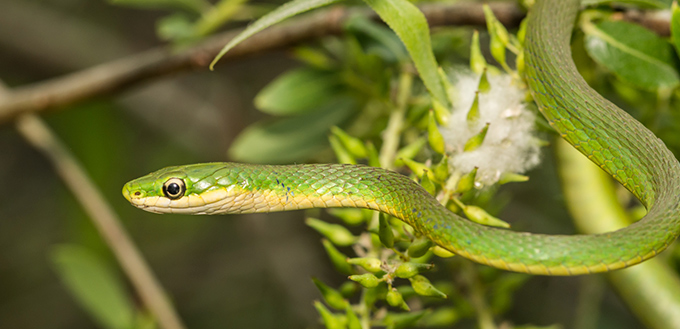
- What bedding do they need?
Bedding is sometimes called substrate and is essential because rough green snakes like to burrow. You can use gravel for this because it is close to your snake’s natural habitat, it is great for burrowing and resists parasites. It is cheap to purchase and can also be washed and reused when you give the enclosure a good clean and this saves you money. Because it holds little water, it will not interfere with the humidity levels.
Related Post: Best Snake Bedding
However, if you don’t want to use gravel, you do have the option of sphagnum moss, coconut husk/orchid bark or mulch. If humidity levels are a challenge for you, cypress mulch and sphagnum moss are the best options because they hold moisture. However, a substrate that is continually wet is not a good idea because it can encourage respiratory infections caused by bacteria.
- Do they need furniture?
In nature, a rough green snake spends most of its time in a tree and close to water so this is the sort of habitat that you are seeking to recreate in the vivarium.
Give them some height to explore by placing branches vertically – this is why you need a tall enclosure for these snakes. Their ideal position is draped over a branch, moving their head from side to side so that they can see what is going on!
However, there are also occasions when they will want to hide and you need to provide somewhere that they can do this. It needs to be big enough for them to curl up in with a small entrance. It also needs to be comfortable and dark inside. When they are ready to shed their skin, they will seek out a moist hide and you can provide this with damp sphagnum moss or paper towels.
A water bowl is essential so that they can drink (although they prefer misted droplets from a spray bottle because it is like rain) and to regulate humidity in the vivarium. It also provides a place to bathe which is important for rough green snakes because they like to live next to water in the wild. They need water to help them shed their skin.
Ideally, you will also provide a large, flat rock where they can bask and you can get hot flat rocks that will store heat from a heat lamp and look just like their natural habitat. Once you get the habitat right, your snake will be happy and this will make them calmer and will increase their life expectancy.
Rough Green Snake Diet & Nutrition
The rough green snake would be categorized as a strict insectivore so they are only interested in eating insects! Ideally, they will need soft-bodied insects so you will have to provide things like spiders and caterpillars but moths and worms are also great as are larvae. They will be willing to try out hard-bodied insects as well so you could get them some grasshoppers and crickets. These are a lot easier to obtain and store than small rodents which are the staple diet of some other snake species.
Ideally, they need a mixture of live and pre-killed insects but make sure that most of their food is already dead. Live food can cause stress to the snake and could even injure them by scratching their eyes so only introduce live food now and again to provide variety.
An adult rough green snake will need to be fed once or twice a week and needs six or seven crickets each time. As a general rule, give them enough food to keep them eating for twenty minutes. However, if they seem to be getting restless and searching for food before their next feed is due, you will need to increase the frequency or the quantity.
Don’t try to feed them by hand at first as they will probably accidentally bite you but with time hand-feeding should be possible. Until you get to this stage, use tongs.
Hatchlings also need feeding twice a week but start them on fruit flies and pinhead crickets and then gradually increase the size of their food. Eventually, switch them to the adult diet. Keep a close eye on your snake and if they appear overweight or underweight, adjust their diet as needed. An underweight snake will have concave sides and an overweight snake is larger around their middle. You will see that their scales have spread and skin is visible beneath.
Rough Green Snake Grooming & Hygiene
You will need to give your rough green snake regular baths. Firstly, this is to keep them clean. They can get food and poop stuck to their skin and need help to get it off. Secondly, they need a bath to add moisture to their skin before they shed.
By having a water bowl in their vivarium, you give them the opportunity to bathe on their own and they can do this without your help. You can also put them in a large bowl of water whilst you are cleaning out their enclosure. The bowl needs to be filled with water that is deep enough for them to sit in but shallow enough for them to raise their head above the water. They need to be in the bath for ten to fifteen minutes. During this time, they may choose to put their head underwater for a few minutes but don’t worry – they can hold their breath for this long! This is their way of removing snake mites from their body. When the bath is over, hold them in a soft towel to dry them. As they move around they will dry off further.
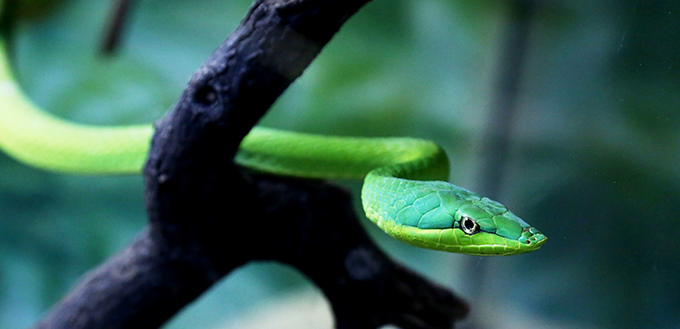
Rough Green Snake Common Health Problems
Rough green snakes are fairly robust but they can suffer health problems caused by incorrect humidity levels. If conditions are too dry, they will retain their shed. This is because the lack of moisture causes the skin and scales to too dry and it will not peel away correctly. A healthy snake will shed all of their skin at once in one piece.
On the other hand, too much humidity also causes problems. Your snake can get respiratory infections and fungal or bacterial infections of the skin including scale rot. A snake with a respiratory infection will breathe through their mouth and have discharge from their nose. You must take them to a vet. Fungal infections of their scales and eyes also require a trip to the vet.
Mouth rot is another common health problem. It happens when the snake’s immune system is weakened, perhaps by stress. If the temperature or humidity is incorrect, the normal mouth bacteria can multiply to higher numbers than normal and cause an infection. This is called ‘infectious stomatitis’ and you will notice that your snake does not want to eat and has a bright red mouth. They may also have pus coming out of their mouth or nose. Take them to your vet for treatment.
Overall, the rough green snake is a docile reptile that makes a good pet for beginners. As long as you keep an eye on the temperature and humidity levels in their enclosure, you can expect them to lead a long and happy life!
Source:
- Steven K. Goldsmith, Aspects of the Natural History of the Rough Green Snake, Opheodrys aestivus (Colubridae), JSTOR





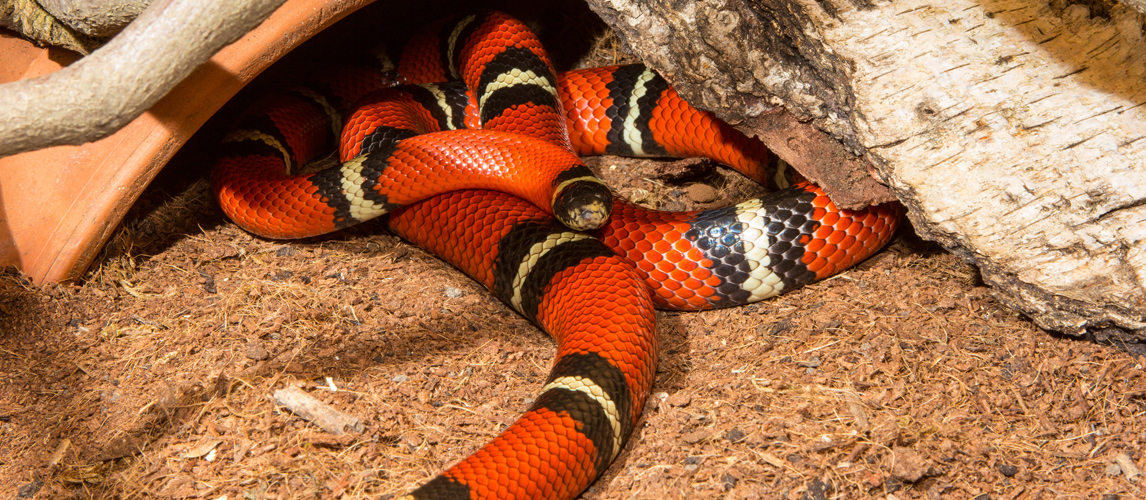
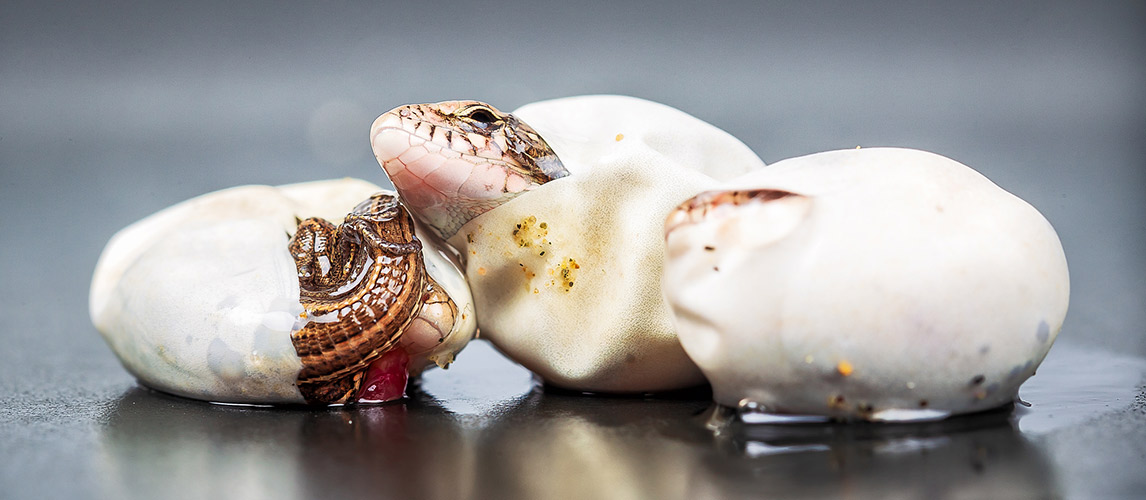

Are the smooth bright green snakes harmful to my dogs???